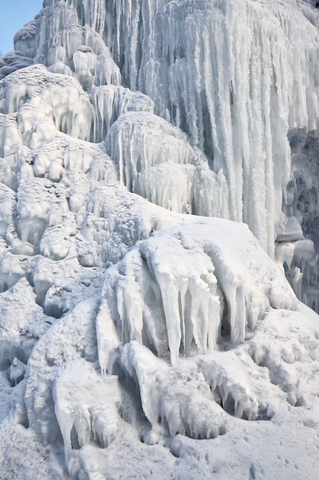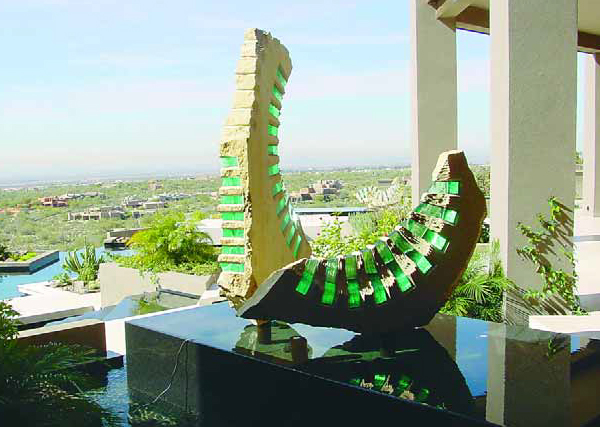sculpture
Way back in my Pool Spa News editor days - I want to say circa 1990, but I may be off by a year or two - we ran a piece on a waterfeature built by Mike Stachel of Mt. Lake Pool & Patio (Doylestown. Pa.) to meet the needs of the Philadelphia Zoo's relentlessly cute capybaras.
I've forgotten all of the details of the article (which, as a small twist of fate would have it, was written by future WaterShapes editor Eric Herman) other than the relentless cuteness of the creatures for whom the watershape was built, but enough of the memory of the project lingered that I made a point of stopping by the zoo while visiting the city ten or twelve years later to see how the critters were getting on. I also wanted to see whether they were as darned cute in person as they had been in Mike's photographs.
I wasn't prepared in any way for the fact that they were actually too large to be considered cute. They were taller and longer and more girthsome than the photos I'd seen had led me to believe. I couldn't help thinking of them as supersized squirrels with bigger, sharper teeth and voracious appetites to match. The horror . . .
Fortunately, there was much else to see at the zoo. Before I was anywhere near the capybara enclosure, in fact, I strolled up to and past the Impala Fountain and knew I'd come back for a longer look once I'd paid my respects to my rodent friends and Mike Stachel's handiwork.
The Impala Fountain belongs to a class of waterfeatures for which I have something of a weakness - that is, fountains that feature wild animals interacting with water. I love the horses running up the steps at the entrance of Denver's Mile-High Stadium, for example, and I'm truly smitten by the mustangs that race across the stream in williams square irving,
The difference in this case is that the impalas (executed between 1950 and 1963 by Philadelphia sculptor Henry Mitchell, are distinctly abstract - basically skeletonized versions of a dozen of these great and amazing leapers set in an arc above fountain jets, doubtless in flight from one sort of predator or another.
To me, this is an ideal combination of sculpture and water where the kinetic nature of the fountain jets lends a direct sense of movement to the static sculptural elements. It's simply drop-dead gorgeous - and well worth a visit the next time you visit the Philadelphia Zoo to see Mike Stachel's fearsome capybaras.
I love the fact that she was a friend and compatriot to Jackson Pollock, Willem de Kooning, Mark Rothko and other leading lights among the abstract expressionists. I love that she lived to be 98 and, just before her death in 2010, was still engaged enough by the world around her to start communicating through her art in support of the lesbian, gay, bisexual and transgender community. I love her name, which would have been the perfect alias for an avant-garde artist of the 20th Century but for the fact that it's really hers. Finally, I love her big sculptures, including the 25-foot-tall one in Agnes R. Katz Park in Pittsburgh, Pa.
Maybe the only thing about Louise Bourgeois' work I think I don't like is that she decided that the 25-foot-tall one in Katz Park would make a good fountain. I just have to disagree with her decision and don't find myself being satisfied or happy in its presence.
The park took shape in 1998 and was dedicated to the memory of Ms. Katz, a prominent patron of the arts. The fountain sculpture dominates the space, which was designed by the renowned architect Michael Graves in collaboration with Daniel Urban Kiley, a distinguished landscape architect, as well as Ms. Bourgeois, who also contributed three paired benches (seen partly in the photo above by Daderot | Wikipedia) that, because of their shapes, have lent the space its nickname: "Eyeball Park."
I savor the oddly disturbing eyeball benches and admire the towering nearby structure as a sculpture, but as I mentioned above, I have my problems with it as a fountain. Yes, I get the symbolism of the two flows at the top joining into a single flow down the structure and its supposed reference to the Allegheny and Monongahela coming together in Pittsburgh to form the Ohio River. But the water element nonetheless seems forced: The sculpture existed before its placement was a consideration; Ms. Bourgeois was a committed New Yorker rather than a Pittsburgher; and I can't help thinking that the plumbing might have been an afterthought?
Mainly, I'm bothered by the timid way the water flows down through the sculpture's levels: It starts out nicely enough at the top but flows unenergetically downward, sometimes narrowing, sometimes expanding as it drops, leaving the structure mostly dry. I tried to convince myself that this worked; ultimately, however, I just couldn't buy it.
Even though it doesn't transport me, however, I do appreciate the fact that the tower runs with heated water and flows a considerate 365 days a year. It was springtime when I saw it, but I wish I'd seen it draped in icicles in the dead of winter (as seen in some photos linked below). I've always been a sucker for the concept of frozen waterfalls, streams and fountains, so, for part of the year at least, this fountain might just win me over.
For all my criticism, I still think it's a great little park in the heart of the city's thriving cultural district - well worth a visit. And frankly, I'd be delighted to hear from anyone who can offer a persuasive defense of the project, because it's pretty clear to me that I'm looking for reasons to appreciate this composition as much as I like so much of Louise Bourgeois' other work!
To see a video of the fountain in operation, click here.
To see the fountain partly covered in ice, click here.
The cold snap that gripped huge parts of the country earlier this month put me in mind of one of my favorite things - and I feel deprived, because I've never lived in a place where such things happen. Back in 1984, Judy and I took a train trip across Canada from Vancouver to Banff. It was November and brutally cold by the time we reached our destination, but we braved the wind and snow to do a bit of hiking in the beautiful terrain near Lake Louise - just breathtaking, both literally and figuratively. While walking along a stream, we came across a cascade that started about ten feet over our heads. It had frozen over for the most part, and I recall the hollow resonance of the water flowing rapidly behind the waterfall's blue-white armor - a sound I've never forgotten. But the visual effect! I've always been a big fan of the Catalonian architect Antoni Gaudí, and there's something about the
I confess to having a weakness for this sort of fountain: There’s probably something about the mixture of water and “animated” sculpture that grabs my imagination in a way that isn’t true of many large-scale water displays.
It this case, it may also have something to do with serendipity and the fact that, the first time I saw this composition, I came upon it entirely by chance. It was about ten years ago, while I was in Irving, Texas, for a series of meetings and had part of a day to myself to walk around and take in the nearby sights.
It was early in the morning when a view of Williams Square opened up and I saw the Mustangs of Las Colinas, a string of larger-than-life bronzes by Robert Glen that seem to run through a narrow watercourse. (That “stream” and the surrounding plaza were devised by SWA Group, a landscape architecture firm with offices in California, Texas and overseas.)
The composition was eight years in the making by the time it was unveiled in 1984, and I remember well the high (and much-deserved) level of attention and praise it gathered in the architectural press at the time.
This is exactly the sort of chance encounter that made me happiest about being a steady traveler for so many years. If you find yourself in the Dallas area and have any opportunity to see this work of watershaping art in person, I strongly recommend the effort!
To see a brief video of the Mustangs at Las Colinas, click here.
In most projects, great work requires the watershaper’s personal understanding of who the clients really are, deep down. That doesn’t mean we have to become our clients’ best friends or marry into their families. Rather, creating watershapes at the highest level involves a different kind of relationship, one in which a


















